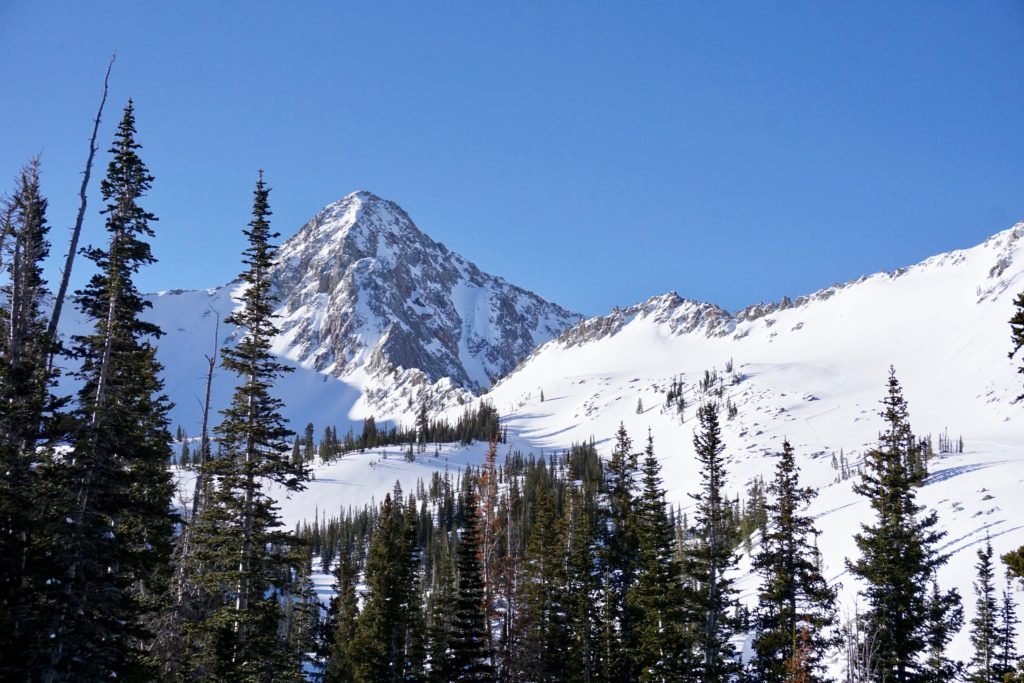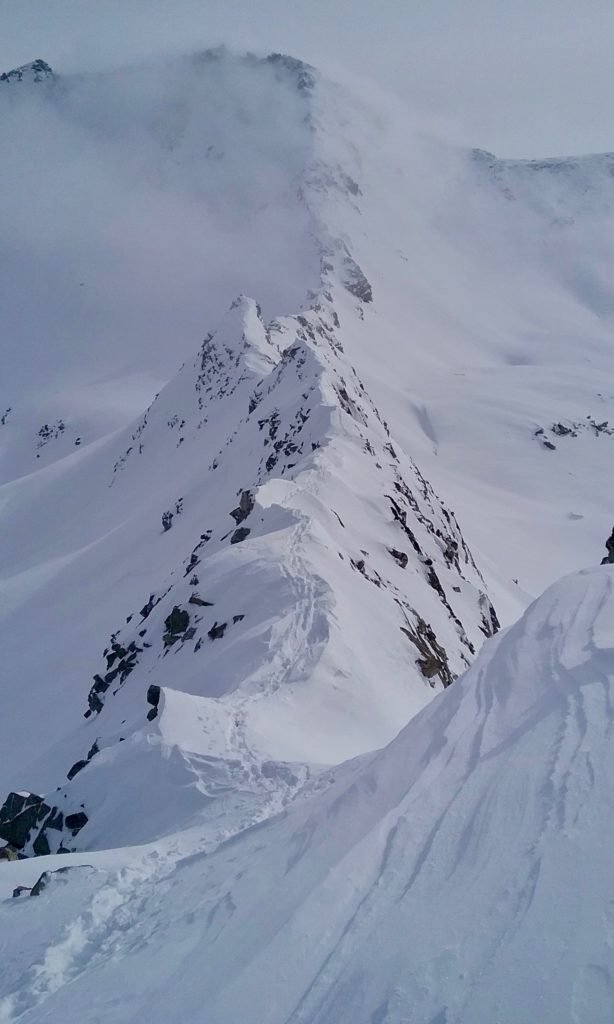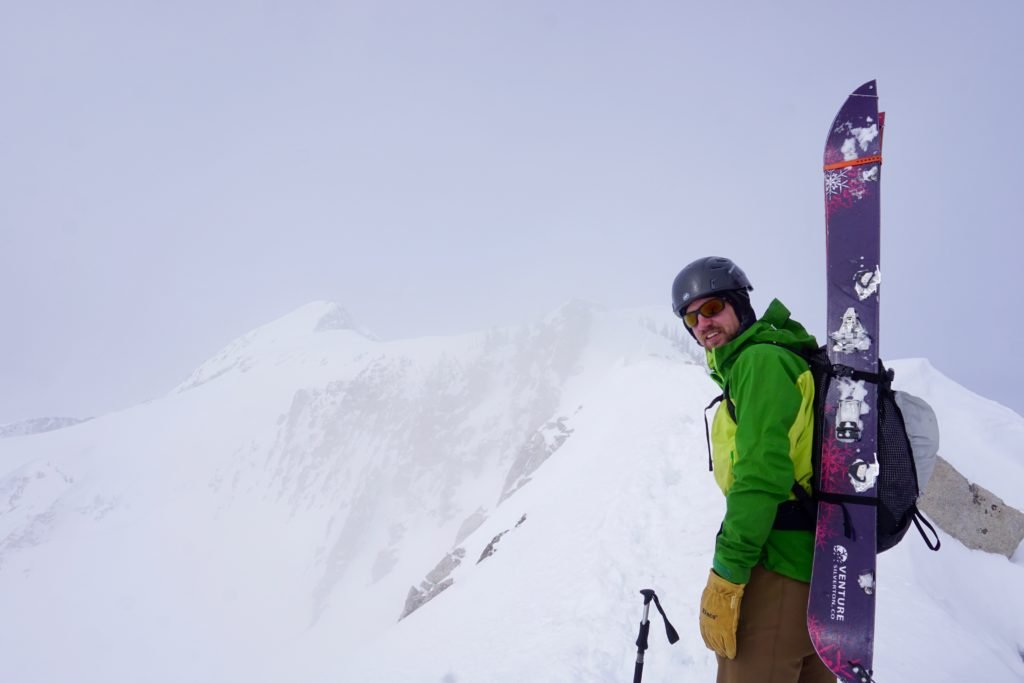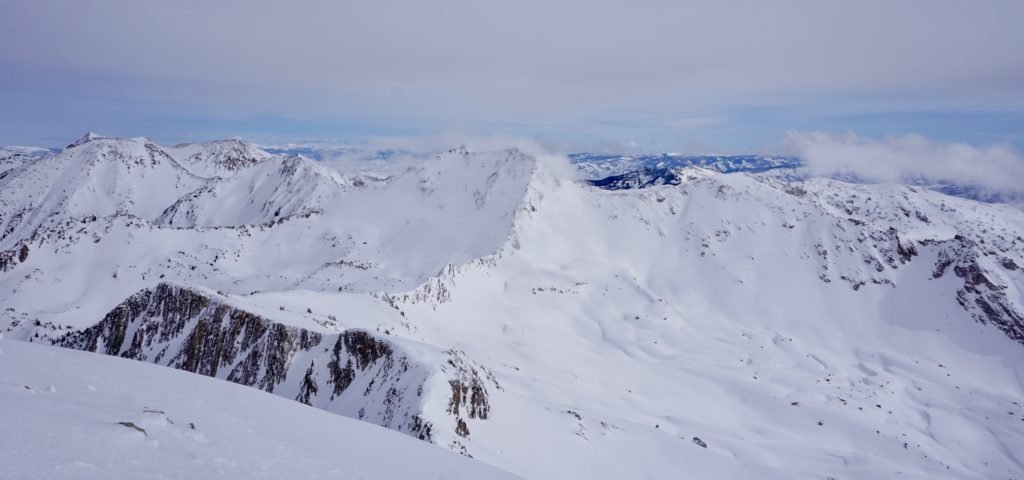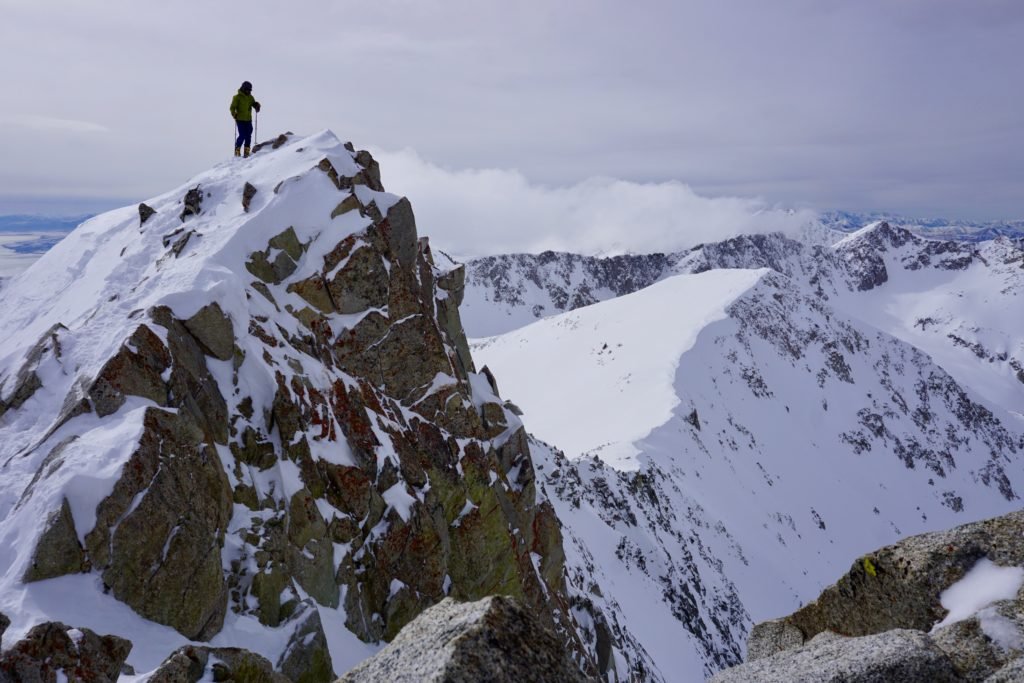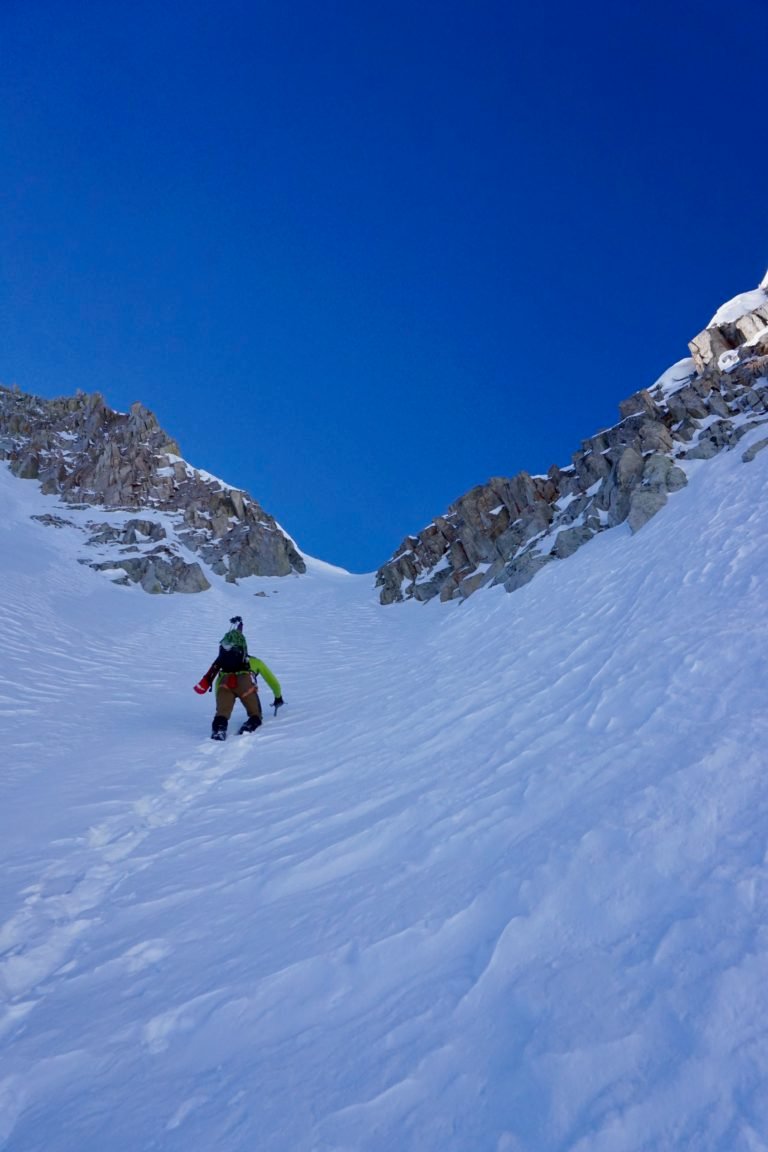My alarm startled me out of bed at 5:55am and, this morning, I knew hitting the snooze button was not an option. The day’s goal was a lofty one but something Tom and I had had our eyes on since much earlier in the season. Standing tall at 11,331 feet, the Pfeifferhorn is the fifth tallest peak in Utah’s Wasatch Range and looms high over the most isolated area of the Lone Peak Wilderness. The North Ridge of this iconic mountain provides winter enthusiasts with a technical alpine climb on snow and rock that necessitates proper planning, trustworthy equipment and partners, and a head for major exposure. I stared up at the ceiling wiping the sleep from my eyes and visualizing the day ahead. My mind wandered to days past and our previous ascent of the Pfeifferhorn’s East Ridge just over a week ago. I saw myself on the summit that we were hoping to reach yet again today.
On February 5th, with a keen eye on the weather and avalanche reports, Tom and I got an early start on our first Pfeifferhorn summit bid. This mission was to serve as a conservative scouting report with the hope that we would score a weather window later in the season to tackle something on this peak with a little more edge. After three and a half miles of skinning in from the White Pine Trailhead in Little Cottonwood Canyon and gaining a couple thousand vertical feet along the way, we reached the frozen and blanketed Red Pine Lakes nestled below our objective. We cautiously kick-turned our way to the top of the steep east-west ridge that marks the top of the gulch and were greeted by more of a thrill than anticipated. The ridge top was wide enough for one but certainly not two and, as we took one step at a time toward the Pfeifferhorn in the distance, we cursed ourselves for leaving crampons and axes behind. The knife-edge eventually gave way to favorable skinning to the base of the East Ridge proper, where we transitioned back to boots and started the steep snow climb to the summit with skis on our backs. Soon, we were looking down on the Lone Peak Wilderness and once again cursing ourselves for treating this as a scouting mission. The classic Northwest Couloir looked invitingly skiable. Lacking the proper gear, including that needed for the mandatory rappel halfway down the chute, we were forced to ski from the summit down the southwest face and into a basin to the south. After descending the crusted face, we were treated to soft powder turns in an otherworldly high alpine environment. Before long we were regaining the home ridge, descending back into Red Pine Fork and skiing trees to the parking lot with fingers crossed that Old Man Winter would offer us another opportunity to explore more of this inspiring mountain.

As I silenced my alarm on the nightstand on the 15th, I woke up knowing we had winter’s blessing. A few days had past between sizable snow and wind events and relatively warm and sunny weather had appeared in the immediate forecast. Tom and I both knew this was our shot. We confirmed this with each other the night before and put together a packing list that far exceeded the typical backcountry tool kit. In addition to the usual weapons of powder destruction, we agreed upon a 60m rope, harnesses, a set of Black Diamond ultralight cams (.5 to 3), a few tri cams, the full gamut of stoppers, plenty of alpine draws, crampons, ice axes, and two-way radios.
I hustled out the door in order to meet Tom at the Little Cottonwood Park and Ride and get an early start on our approach to the North Ridge. We divvied up gear and hit the skin track just past sunrise. The four-mile approach took us up nearly 3,000 vertical feet deep into Maybird Gulch, and we became bracketed by jagged ridge lines as the Pfeifferhorn’s North face finally came into view. We both noted that from this angle the climb appeared more dramatic than we imagined but trudged on to the base of our ascent couloir to start the upward climb to the ridge. It was time to attach skis to backpacks, crampons to feet, and have an ice axe at the ready in order to safely climb the 30° – 50° gully. We exchanged leads up the couloir and before long topped out on a narrow knife-edge with a few hundred feet of exposure on either side. The ridge top snow was only broken up by the occasional rock outcropping, which happened to be just enough to build our first anchor. We each tied into an end of the rope and were set to safely begin our ascent.
Tom took the first lead, slowly working his way across snow and rock and disappearing out of site while tiptoeing the ridge that gave way to nothing but air on either side. I buzzed Tom on our radios to let him know how much of the 60m rope was left to work with. He used most of it to reach a big boulder and create a second anchor in order to belay me up the first pitch. I cleaned gear and shortly met Tom at the bottom of the second pitch where it was my turn to lead.
I took off from our narrow and highly exposed belay ledge in the snow and was immediately greeted with what would be the most difficult section of this pitch. A jumble of frozen rocks and larger outcroppings protruded from the snow. I wedged my way into them, attempting to stem the rock faces on either side of me with the front points of my crampons. With no great spot to place any protection, I huffed and puffed my way upward before finding some respite in a snowy step in the rocks. Finally, I was able to place some gear into the rock and took a deep breath as the skis on my back banged against the cliffs on either side. The climbing soon became much more manageable. I emerged from the crack and onto some steep snow where I had ample opportunities to sling runners around rocks and clip the rope in for added insurance. I transitioned back to using my ice ax as a near guaranteed steadfast hold in the hard pack snow. The pitch continued a little further to an open ramp of snow as wide as a crosswalk, offering a welcome break from having to stare down into the abyss for the previous two sections of the climb. More of a blessing, however, was the ability to finally bask in some sunshine at the belay after hours of climbing in the shadow of the Pfeifferhorn.
We swapped leads again at this anchor, and Tom edged his crampons out onto a ledge no wider than a ski boot. As was becoming the nature of this climb, below his feet was a cliff plunging into nothingness. In front was a wide slab of rock that, in summertime, would make for easy upwards travel. In February, things were a little trickier with snow caked in every crack – effectively masking all hand and foot holds as well as spots to place protection. Tom dusted snow off and cautiously found a proper line up to the top of the slab, stopping only occasionally to maintain warmth and blood flow in his gloved hands. He began traversing north and running the rope out to the base of what would be the crux pitch. At this point I couldn’t help but notice the sun’s position in the sky, the time on my watch, and the distance left to the summit. Efficiency, an already vital skill when climbing, was soon to become even more paramount.
On Tom’s call I cleaned the bottom anchor and followed the rope upwards, trying not to think too hard about the air below. While front pointing crampons on slabby rock is not my preferred method of travel, this pitch provided some interesting moves and required a calm and meditative headspace while traveling upwards. When I reached Tom at the top, he had had the same realization I did on the last belay. Time was of the essence. We discussed potential contingency bailout options and mutually decided that pushing onward would be faster and easier regardless of the time. Backtracking would require a series of complicated and uncomfortable rappels that simply didn’t make sense in our current situation.
Now, anchored in at the bottom of the crux pitch and final section of serious climbing while racing a setting sun, it was gut check time. The previous pitches had tested our alpine skills, mental capacity for long periods of high consequence exposure, and extremity circulation. Previous climbers had identified the remaining pitch as the hardest part of the climb, and neither of us was particularly keen to lead it. Tom, sensing my apprehension, took charge as I clipped into the anchor to belay from below. This pitch was comprised of the steepest section of rock we had yet encountered and required alternatively using hands and axe to climb it effectively. Before taking off we discussed our plan moving forward. Tom would build an anchor in a reasonable spot and, when I emerged from the top of the steep rock section and transitioned onto the awaiting snowfield, we would quickly prepare to simul climb the final few hundred vertical feet to the summit.
Tom methodically climbed onward through a tricky traverse around the unmistakable lightning bolt crack with, naturally, nothing but sheer cliffs leading down to the meadowy snowfield over 1,000 feet below . I watched anxiously as Tom climbed out of sight to my left and the sun began to set to my right. We were in a tight spot, and up was the only way out.
Soon my end of the rope pulled taut on my harness. Game time. I began my ascent of the final pitch with Tom belaying me from above. What was undoubtedly a head rattling lead was actually a fairly comfortable follow. Perhaps the adrenalin provided by a setting sun was coursing through my veins, but I was able to move with predatory focus through this section retrieving gear along the way. Unfortunately, toward the top of the pitch, I made the mistake of trying to retrieve a well-placed cam with a numb and gloved hand. I pushed it into its crack a bit too far – wedging it into an irretrievable position far back in the rock. Having a keen awareness of the relative urgency of our current situation, I opted to not fiddle too long trying to jar it loose but instead kept climbing to preserve as much of the diminishing daylight as possible.
With a deep breath, I crowned over the top and gave Tom a celebratory holler. We had completed all of the toughest sections and all that remained between the summit and us was a steep snowfield. Tom and I stayed tethered to each other as he began pushing onward moving vigilantly toward the summit. Simul climbing allowed us to more efficiently race the sunset. Tom put slings around the occasional rock for protection, and I followed close behind. We moved quickly, relying on our ice axes to protect a fall if one of us was to slip on the snow.
While the summit was well within view, it didn’t appear to get any closer. Fatigue was setting in fast, but taking a break was simply not an option. Adrenalin surged and, together, we gained the summit. After a quick high five we immediately went into transition mode.
Tom hastily texted Casey, the one person who knew our objective for the day, as his cold near-dead phone went from zero bars of service to two:
“On summit of Pfieff. Descending now. Maybird to Red Pine to White Pine Gulch. Back to car by 8:30pm.”
The sun had dropped below its final ridge, and now we were working in ambient dusk to descend the East Ridge and drop into Maybird Gulch. I stuffed our climbing rack into my bag and crossed the summit onto the east face to make a call on snow quality. Tom coiled the rope. Given the lack of lighting and hard pack snow conditions above a a 200-foot cliff and absolute no-fall zone, we decided the safest plan would be to down climb in our crampons with axes at the ready. We moved quicker than ever as I realized that I foolishly forgot to transfer my headlamp into my current backpack from the one I used on a yurt trip the week prior. It was imperative that we descended the peak with some semblance of natural light.
We got off of the Pfeifferhorn and onto the ridge at the top of Maybird Gulch just as the blanket of night was pulled over our eyes. City lights illuminated the far horizons to both the north and south where over two million residents were undoubtedly enjoying the comforts of home.
I dug into my backpack and pulled out my first aid/survival kit and gave a holler upon remembering that a headlamp (with batteries) was included in the kit. We were almost in the clear. Ahead of us was a steep descent into Maybird Gulch. Undoubtedly an exciting challenge, Tom and I were just thrilled to have our crampons packed deep in our bags with snowboard and skis underfoot, respectively. This shot into Maybird Gulch provided some surprisingly fun powder skiing by headlamp once the first few survival turns were behind us. The starlit Pfeifferhorn was our backdrop, and the North Ridge was to our left flank, as we carved turns down to safety.
Tom and I reunited in the gut of the gulch using headlamps as literal beacons of light to keep an eye on each other. The countless stars overhead were made that much more beautiful knowing that we had left all of the high consequence terrain behind us and could confidently work our way down the remaining 3,000 vertical with little concern, darkness be damned. We skied psychedelic powder by headlamp and starshine to the mouth of Maybird Gulch before traversing down and out back toward the parking lot. The dimly lit powder fields scattered between towering aspens offered us some celebratory, albeit exhausted, turns as we joked that people are actually paying to night ski with the crowds on groomers at this very moment. We, on the other hand, had a canvas of stars and an entire section of the Wasatch backcountry to ourselves.
Our sore legs and utter fatigue were quickly catching up to us, though, and we couldn’t have been more thrilled to find the now icy skin track that we had relied on for uphill travel hours early. We surrendered the powder and opted to follow the well-worn WasAngeles uptrack down to the car. We could finally, safely, celebrate the day’s adventure at 8:50pm – well over 12 hours later.
As Tom collapsed into the passenger seat he joked, “We probably should have let someone know we were going for a speed ascent record on the North Ridge today. I think we would have had it in the bag.”
We drove down Little Cottonwood debriefing the mission and soon parted ways. The previous hours were blurred in a shroud of excitement and exhaustion, but the stoke was high. So many things worked out in our favor and, as always, the mountains were beckoning to teach. I slowly began to diffuse the adrenalin still coursing through my veins while simultaneously reveling in the events of the day – and did what any exhausted, underfed, and dehydrated male in their late 20s would do. I sucked up my pride, went to the Wendy’s drive through, maximized the dollar menu, and collapsed on the couch. It was just after 10:00pm, 16 hours since leaving home that morning. As I drifted off to sleep, my thoughts wandered between our day on the Pfeifferhorn, the dynamic magic of the mountains, the simple beauty of the wilderness, and the fact that, tomorrow, I wouldn’t have to wake up to the buzz of an alarm.
